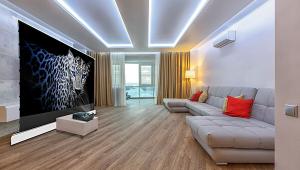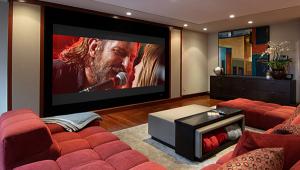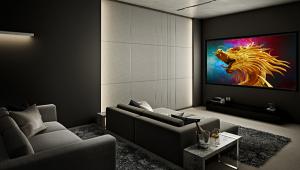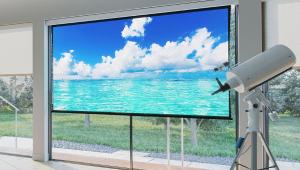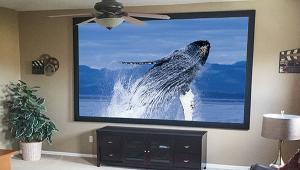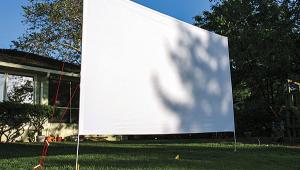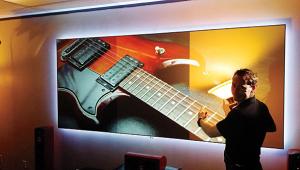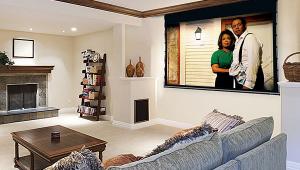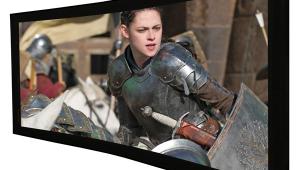This may be a dumb question, but are any of the screens innacurate on color when viewing on axis? I sit dead center on the screen, and the rest of my seating is within the viewing cone of the screen. Dead center will the Studio 130 be any more accurate than the Hi Power?
Stewart Filmscreen Reflections Active 170 3D & Da-Lite High Power Projection Screens

Price: Varies by size, type (see review) At A Glance: Higher gain than popular StudioTek 130 G3 • Good off-axis performance and color uniformity • Noticeable hot spot
Da-Lite High Power
Price: Varies by size, type (see review) At A Glance: High Gain • Picture darkens visibly off-axis • Hotspotting virtually undetectable
We’ve come a long way from the days when screens were an afterthought. I imagine there are still a few enthusiasts who cut their projection teeth on a sheet or a bare white wall, or even an old, beaded, home-movie screen. Today we know better. The screen is a vital part of the projection setup.
Screens now come in a wide variety of sizes and characteristics. Their physical construction—fixed frame, retractable, flat or curved, masked or unmasked, perforated or not—is a subject for another day. There are also rear-projection screens. Here, however, we’re primarily concerned with the characteristics of the screen material itself, as used in front-projection setups, the type most commonly found in theaters, both commercial and home.
The most important of these characteristics is gain. A screen that reflects the light from the projector more or less uniformly in all directions is said to have a gain of 1.0. The reference for this is a Lambertian Diffuser. Screens with gains ranging from 1.0 (or less) to 1.3 have long been the most popular among videophiles. The Stewart Filmscreen StudioTek 130 G3 and the Da-Lite Cinema Vision, to give just two popular examples, have rated gains of 1.3. These offer 30 percent more brightness than a gain of 1.0 and became popular during the CRT projection days, when every little bit helped.
A gain of 1.3 or less, if properly implemented, is still a useful option. We certainly plan to continue using such screens as references here at Home Theater. While many video projectors are now significantly brighter than those old CRTs—and at prices never dreamed of in that era—that extra brightness has upped the popularity of larger screens. Over the past decade, that trend has ushered in a wider variety of new screen designs with gains even higher than 1.3.
There’s yet another factor driving the need for highergains screens today: 3D. Three-dimensional projection results in a dramatic loss of brightness. Moviegoers have embraced 3D, but more than a few have com- plained that the loss of brightness is a serious distraction. Unless you frequent an IMAX theater or a similar 3D venue that uses two projectors, you’ll be lucky if the 3D brightness is 30 percent of what the theater delivers in 2D.
The same is true at home; but there, the losses can be even more pronounced. Your local cineplex has most likely installed special high-gain screens in its 3D auditoriums. But if you use your old, 1.3-gain screen with that shiny new 3D projector, you may be in for a shock. The result may be satisfactory if your screen is relatively small, but the loss of brightness will still be apparent. With a larger screen, and depending on the projector, it might well dampen your enthusiasm for viewing 3D at home.
The High-Gain Alternative
Admittedly, we at HT have avoided high-gain screens like the plague, as have many video purists. There are legitimate reasons for this. Screens are passive devices, so logic says the only way they can produce gain is to focus more of the light from the projector toward the middle of the viewing area. This means that you’ll see the brightest image only if you sit dead center. If you’re sitting anywhere else, the drop in brightness will be more pronounced than with a low-gain screen. The higher the gain, and the further off-axis the viewing angle, the greater that loss will be. There is no free lunch.
Screen manufacturers typically rate their products by specifying the off-axis viewing angle, which is the angle at which the image will measure half of its on-axis brightness. Fortunately, our eyes don’t respond linearly to a drop in measured brightness. In our vision, this decrease is visible, but generally not as dramatic as the term “half brightness” might suggest.
High-gain screens can also exhibit other oddities. Their color may not be as uniform off-axis as a well-designed, low-gain screen, because the ways in which they reflect the red, green, and blue light from the projector can vary. More significantly, the higher the gain, the more the screen is prone to showing a hotspot. This will be most visible on a full field of uniform color (or white) as a brightening at the center of the screen, although it can shift position depending on the viewing angle. Unless it’s severe, however, it will be less conspicuous with most program material, where complexity and motion can mask it.
Despite these issues, a high-gain screen can be a useful option. With a large screen, a projector with less-than-sterling light output, or one projecting 3D, a higher screen gain can make the difference between a bright, compelling, home theater experience and a dim, bland one. What follows is Home Theater’s first look at such screens, one of them already well established, the other introduced last year.
No projection screen, regardless of its design, can produce as good a picture in a brightly lit room as in a completely darkened one. That goes for special screens designed for just this purpose. We’ve tested several of them and they don’t perform miracles, but they can help when a pitch-black room is simply not an option. Brightening the image for use with room lighting is not really the main purpose of the conventional, high-gain screens we will look at here. Nevertheless, since a higher-gain screen focuses the projector’s light toward the center, it should reflect less light toward the sidewalls, floor, and ceiling. Less light will therefore bounce back onto the screen, and the reduction of such reflections can enhance the visible contrast. The latter was not a factor in our tests; when the lights are out, our test studio is a dark cave.
Pricing for any screen varies by size and format. As an example, the 96-inch-wide Stewart Reflections 170 reviewed here lists for $2,682 in the Luxus Deluxe fixed frame, or $6,425 in the premium retractable Cabaret version. The 96-inch Da-Lite High Power goes for $1,342 in an Electrol retractable case.
All of the results in this review assume a projector with a decent brightness level. That’s the one variable our judgments cannot universally account for. Things are looking up in that respect, however, particularly at the more affordable end of the market.
Of the current projectors we have the most experience with, the home theater models from JVC and Sony all meet this requirement. The tests and viewing in this review utilized a JVC DLA-X70R projector with approximately 200 hours on its lamp. Although two slightly different screen sizes are represented, all 3D measurements were taken at the 92-inch image size associated with the smallest of the two.
Stewart Filmscreen Reflections Active 170 3D
Professed to offer fine performance with both 2D and 3D sources, Stewart Filmscreen’s new Reflections Active 170 3D is rated for a gain of 1.7 and a half-brightness, off-axis angle of 40 degrees. It has a smooth surface finish, but a visible hotspot. Bright sparkles also appear when you’re nose to nose with the screen. From a normal viewing distance, these sparkles blend together into a granular sheen. These anomalies are most visible on a bright, full-field-white test pattern. The average viewer is unlikely to be conscious of them because they’re hard to spot in normal program material.
- Log in or register to post comments


